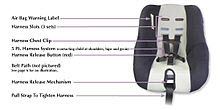Regrettably, many parents don’t recognise that there are actually quite strict rules for baby and child car seats, also it quite definitely depends upon age and measurements of the little one in regards to what type of seat they must be using. The danger to kids of being hurt in a motor vehicle crash is amazingly high, and this risk has a tendency to increase as children grow older. Many parents are incredibly safety conscious with very young children with regards to car safety, but as children grow older this safety emphasis is often forgotten, resulting in higher amount of injuries and deaths to youngsters over the age of 4. Being mindful of this, let’s consult the American Academy of Pediatrics’ guidelines and check out the four main categories of children’s car seats, and just how and also when they should be used.
Babies and Toddlers up to 2
This is probably the age-group that parents are most aware of. Babies and toddlers up to the age of two should always be securely strapped in a rear-facing baby seat. The only exception to this is where the child has outgrown the recommended max height or weight as set out by the seat manufacturer. Parents should ensure that the seat is securely fastened and that the child is snug. It’s also worth considering not securing your baby when they are wearing large puffy jackets, as this can result in a less than secure restraint.
Toddlers and Preschoolers
As soon as a child has outgrown their rear-facing seat, they should be moved into a forward-facing child seat for as long as they fit the manufacturer’s guidelines. Those with convertible or 3 in 1 seats can adjust as necessary when the child reaches this age. As with rear-facing seats, securing the seat properly and restraining the child appropriately are of critical importance.
School-Going Children
This is a very broad term, and very much depends on the size of the child, but children who have outgrown their forward-facing child seats should be moved on to a booster seat. Booster seats should continue to be used until the child is at an appropriate size to use the adult’s seatbelt in the car. Again, the manufacturer’s guidelines will be relevant here, but a good general guideline for transitioning from a booster seat is when the child reaches a height of around 4 foot 9.
Older Children
Finally, when children have outgrown any booster seats (often between the ages of 8 and 12), they should move on to using the seatbelts provided in the car. It is vital that children only do so when they are large enough to comfortably use the seat. In this regard, it’s also important that children do not use accessories on their seatbelt, nor try and make the belt more comfortable by tucking it under their armpit. This is not approved and very much does increase the risk to the child.
